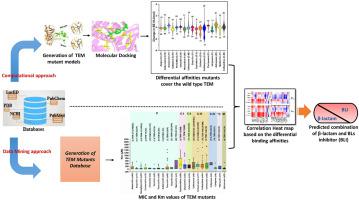Environmental Pollution ( IF 7.6 ) Pub Date : 2022-09-27 , DOI: 10.1016/j.envpol.2022.120289 Priyanka Gehlot 1 , Hariprasad P 1

|
β-lactams are large group of antibiotics widely used to suppress the bacterial growth by inhibiting cell wall synthesis. Bacterial resistance against β-lactam antibiotics is primarily mediated through the production of Temoneria (TEM) β-lactamase (BLs), with almost 474 variants identified in Lactamase Engineering Database (LacED). The present study aims to develop a model to track the evolution of TEM BLs and their interactions with β-lactam and BLs inhibitors through data mining and computational approaches. Further, the model will be used to predict the effective combinations of β-lactam and BLs inhibitors to treat the bacterial infection harbouring emerging variants of β-lactamase. The molecular docking study results demonstrated that most TEM mutants recorded the least binding energy to penicillin and cephalosporin (I/II/III/IV/V generations) class of antibiotics. On the contrary, the same mutants recorded higher binding energy to carbapenem and Monobactam class of antibiotics. Among the BLs inhibitors, tazobactam recorded the least binding energy against most of the TEM mutants, indicating that it can lower the catalytic activity of TEM BLs, thereby potentiating antibiotic action. Similarly, data mining work has assisted us in creating a database of TEM mutants that has comprehensive data on mutations, bacterial diversity, Km, MIC, and IRT types. It has been noted that earlier released antibiotics like amoxicillin and ampicillin had lower Km and higher MIC values, which indicates the prevalence of bacterial resistance. By analysing the differential binding energy (ΔBE) of the selected TEM mutants against β-lactam and BLs inhibitors, the most effective combination of β-lactam (carbapenem and monobactam class of antibiotics) and BLs inhibitors (tazobactam) was identified, to cure bacterial diseases/infections and to prevent similar antibiotic resistance outbreaks. Therefore, our study opens a new avenue in developing strategies to manage antibiotic resistance in bacteria.
中文翻译:

计算和数据挖掘研究以了解 Temoneria (TEM) β-内酰胺酶的分布和动力学及其与 β-内酰胺和 β-内酰胺酶抑制剂的相互作用
β-内酰胺是一大类抗生素,广泛用于通过抑制细胞壁合成来抑制细菌生长。细菌对 β-内酰胺类抗生素的耐药性主要是通过产生 Temoneria (TEM) β-内酰胺酶 (BLs) 来介导的,在内酰胺酶工程数据库 (LacED) 中发现了近 474 个变体。本研究旨在开发一个模型,通过数据挖掘和计算方法跟踪 TEM BLs 的演变及其与 β-内酰胺和 BLs 抑制剂的相互作用。此外,该模型将用于预测 β-内酰胺和 BLs 抑制剂的有效组合,以治疗含有新出现的 β-内酰胺酶变体的细菌感染。分子对接研究结果表明,大多数 TEM 突变体对青霉素和头孢菌素(I/II/III/IV/V 代)类抗生素的结合能最低。相反,相同的突变体对碳青霉烯类和单巴坦类抗生素的结合能更高。在 BLs 抑制剂中,他唑巴坦对大多数 TEM 突变体的结合能最低,表明它可以降低 TEM BLs 的催化活性,从而增强抗生素作用。同样,数据挖掘工作帮助我们创建了一个 TEM 突变数据库,其中包含突变、细菌多样性、Km、MIC 和 IRT 类型的全面数据。已经注意到,较早发布的抗生素如阿莫西林和氨苄西林具有较低的 Km 和较高的 MIC 值,这表明细菌耐药性的普遍存在。通过分析所选 TEM 突变体对 β-内酰胺和 BLs 抑制剂的差异结合能 (ΔBE),确定了 β-内酰胺(碳青霉烯类和单环内酰胺类抗生素)和 BLs 抑制剂(他唑巴坦)最有效的组合,以治愈细菌疾病/感染,并防止类似的抗生素耐药性爆发。因此,我们的研究为制定管理细菌抗生素耐药性的策略开辟了一条新途径。











































 京公网安备 11010802027423号
京公网安备 11010802027423号